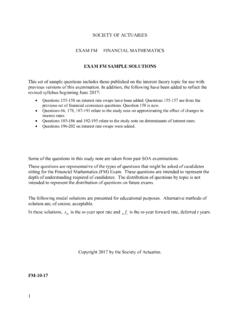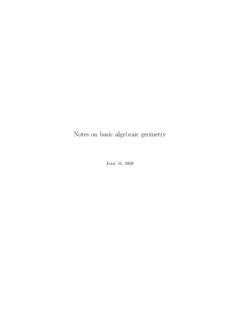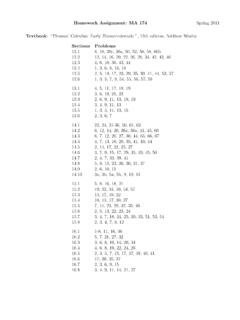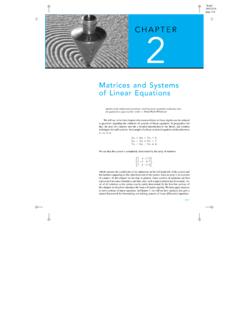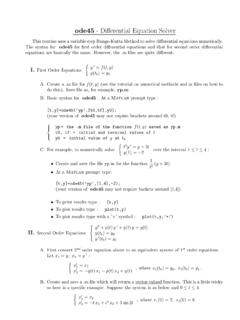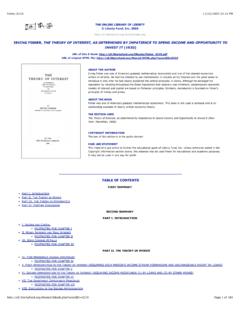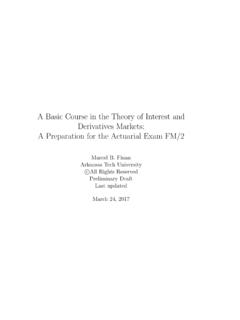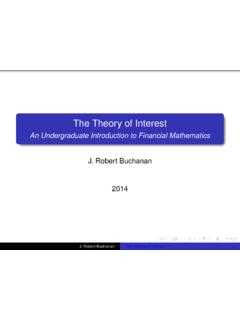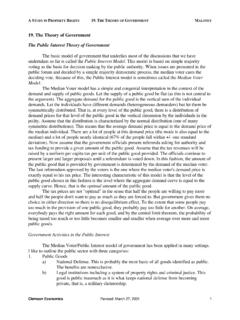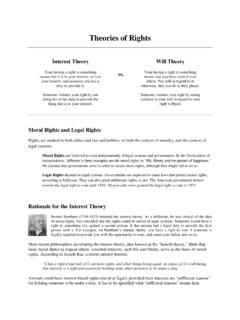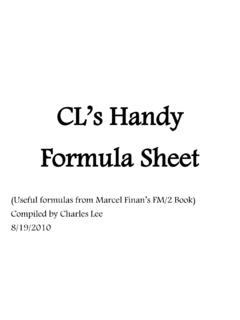Transcription of Interest Theory Richard C. Penney Purdue University
1 Interest TheoryRichard C. PenneyPurdue UniversityContentsChapter 1. Compound TI BA II Plus Calculator52. Compound Interest63. Rate of Return184. Discount and Force of Interest255. Annuities276. Loans357. Processes439. Depreciation Methods4510. Capitalization Costs4834 CONTENTSCHAPTER 1 Compound Interest1. The TI BA II Plus CalculatorA nancial calculator approved by the SOA is required for the Course 2 Actu-arial recommend the TI BA II Plus, either the solar or battery will discuss some of the details of its operation in these notes as the need , a few initial comments are in will probably want to change some of the default settings for the the defaults is accomplished by pressing [2nd][FORMAT] and using theup/down arrows to browse the format menu.
2 Changes are made either by enteringa value or pressing [2nd][SET] to change a changes you make remainpermanent until you either replace the battery or enter[2nd][RESET].To e x it theFORMAT menu, press [CE/C].Some changes you might want to make are:1. By default, the BA II rounds the display to 2 decimal accuracy, despite thefact that it stores them, and works with them, to a much higher degree ofaccuracy. This can present a problem if you, say, record answers on paper forsubsequent use in further calculations; two decimal accuracy is not su cientfor many applications. We suggest that you reset the value of theDECvariable in the FORMAT menu from 2 to By default, the BA II does not follow the standard rules concerning the orderof operations.
3 Instead, it computes numbers in the order they are , entering 2+3 6 produces 5 6 = 30 rather than 2+18 = 20. To get theBA II to behave more like a standard scienti c calculator, we suggest thatyou reset theCnn(chain calculation) variable toAOS(Algebraic OperationSystem) by scrolling down to Cnn and pressing [2nd][SET].3. If you use the BA II for other classes, you might also want to change theDEGvariable BA II remembers the values of all registers, even when turned o . Hence,every time you begin a new session, you should enter [2nd][CLR WORK] and[2nd][CLEAR TVM] to clear out all registers. Don't use [2nd][RESET] as thiswill also reset the defaults.
4 Similarly, you should enter [2nd][CLEAR TVM] at thebeginning of each new problem if you have accessed TVM features of the BA II. Ifyou have used other work sheets, you should also enter [2nd][CLR WORK]. calculators are not as useful on the Course 2 ActuarialExam as one might expect. Few of the problems may be solved using only is essential that you learn to use the formulas as well as how to usethe this reason, we will insist, at least initially, that you write aformula for the solution to all assigned homework problems, even if you do thecomputations on the COMPOUND INTEREST2. Compound InterestThe simplest example of Interest is a loan agreement two children might make:\I will lend you a dollar, but every day you keep it, you owe me one more penny.
5 "In this example, the Interest rate is 1%/day and the amount owed aftertdays isA(t)=1+:01tIn this formula, the quantity:01tis the Interest at timet. (In general, the interestis the di erence between what was borrowed and what is owed.) the above example, we can describe the Interest rate as a percent(1%) or as a numeric value ( .01).When we state an Interest rate we will alwaysmean a numeric value, and not a percent, unless we indicate these notes, we use the year and the dollar as our fundamental units as thisis most common in actuarial science. We will assume that, unless otherwise stated,all Interest rates are per unit time{ per year.}
6 However, the reader should beaware that all of our formulas are valid regardless, of the units of , as above, the Interest is proportional to time, then we say that the interestissimple quantity grows at a rateisimple Interest if the amount attimetis given byA(t)=(1+it)P(1)for some (t)is also referred to as the \future value at timetofPat simple Interest ratei."Pis referred to as the \present value at time 0 of theaccount at simple Interest ratei." Jan. 1 of a non-leap year, I invest $5,000 at 3% simple much do I have on May 1? How much would I have in 3 years? May 1, I have had the money for 3 31 + 30 = 123 days, whichis 123=365th of a year.
7 Hence, I have(1 +123365:03)5000 = 5050 3 years, I have(1 + 3(:03))5000 = 5450 computing Interest , it is typically assumed that Interest is earnedonly on either the rst day the account is open or the last day, but not on day doesn't matter in computing the Interest . Thus, in Example 1, it iscorrect not to count the Interest earned on May question of how many days are in a year is actually somewhat most obvious answer is that a year will have either 365 or 366 days, dependingon whether or not it is a leap year. It has to be remembered, however, thataccounting practices became standardized long before even hand held calculatorswere available, not to mention personal computers.
8 Thus, many schemes have beendeveloped to simplify hand example, it is common to not give Interest on Feb. 29, in which case allyears e ectively have 365 days. Another method, referred to asexact Interest ,isto give Interest on leap day, but still say that all years have 365 days. Thus, under2. COMPOUND INTEREST7this standard, at thenth day of the year,Pdollars invested at rateisimple interestgrows to(1 +n365i)PIn particular, at the end of a leap year, you have(1 +366365i) is another method,ordinary Interest ,(not to be confused with \simpleinterest") in which it is assumed that all months have 30 days and every year has360 days! Thus, if you opened an 4% account on Jan.
9 1 1950 and closed it on May10, 2002, you held your money for 51 years, 4 months and 10 days which, accordingto the rules of ordinary Interest , is51 360 + 4 30 + 10 = 18490days. HencePdollars invested at rateisimple Interest will have grown to(1 +18490360:04)Pdollars. Ordinary Interest has the feature that each month is 1=12 of a thisclass, unless otherwise stated, we will use ordinary Interest as this greatly simpli escounting is also something calledBanker's rule,in which every year has 360 days,but you count the exact number of days you have held the money in computing theinterest. To use Banker's Rule on the preceding example, you would have to countthe days between Jan.
10 1, 1950 and May 10, 2002 and use this number instead ofthe use of exact Interest is common in Canada while the Banker's rule iscommon in the US and in international Interest is much more common than simple Interest . Suppose, forexample, that I investPdollars at ratei, compounded yearly. As with simpleinterest, at the end of the year, I haveA(1) = (1 +i) compound Interest , however, I earn Interest on the total amount on de-posit at the beginning of the compounding period, not just the original , in another year, my account will again grow by a factor if (1 +i), yielding(1 +i)2 Pdollars. Afternyears, I haveA(n)=(1+i)nP(2) the end of 1980, I deposited $1,000 in an account that Interest , compounded yearly.


